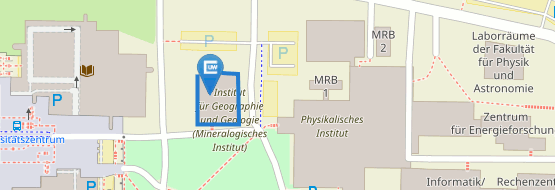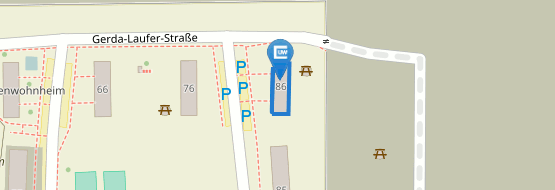Emission sources from satellite data for improved pollen forecasting in Bavaria (ESPE)

- Subject: Environmental health, digital health, forest monitoring, forestry
- Study site: Bavaria
- Funding: Bavarian State Ministry of Health and Care
- Contact: Michael Thiel, Insa Otte, Thorsten Dahms
Motivation
Currently, more than 20% of adults and 15% of children and adolescents suffer from an allergic-atopic disease. In Bavaria, this includes about 2 million adults and 300,000 children and adolescents. Thereby, about 80 % of all allergy sufferers are pollen allergy sufferers. These diseases caused total costs of about 600 million euros in Bavaria in 2013. The goal of the Bavarian state government is therefore a valid and practicable pollen forecast, which is characterized by both the highest possible spatial resolution and the earliest possible prediction.
The occurrence of allergenic pollen such as from grasses and trees can be predicted with different spatial numerical models based on weather and satellite data. The prediction quality of the existing prediction models is currently very coarse in terms of the spatial resolution of the model results.
The ESPE project aims to optimize pollen modeling by incorporating current high-resolution forest and open-land maps of Bavaria into forecast models.
For this purpose, freely available satellite-based Earth observation data of the Copernicus Sentinels and innovative "Data Cube" spatial data infrastructures are used.
Aim of the project
The modeling of grass and tree pollen flight is currently based on a temperature sum-driven, species-specific model ("SILAM" model of the Finish Meteorological Institute), which is based on a grassland and forest map in 1 km resolution. This approach can be improved by various remote sensing-based input data.
Small-scale and always up-to-date delineation of emission sources of allergenic pollen can improve the prediction accuracy of pollen models. Data and research needs could be identified especially with respect to high spatial resolution (<30 m) forest type maps as well as temporally differentiated land use types and land use dynamics in permanent grassland in order to optimize the detection of local pollen emission sources from forests and permanent grassland. The following three substantive objectives will be realized in the project:
1. Improvement of the baseline mapping of the current distribution of grassland and forest stands using Copernicus Sentinel-2 satellite data for the Free State of Bavaria.
2. Optimization of the remote sensing based coverage of forest types and permanent grassland areas including land use dynamics as emission sources of pollen.
3. Potential analysis to improve pollen forecasting by integrating thematically and spatially high-resolution land cover information with in-situ measurements and pollen models.
Innovative Approach in ESPE
Cloud-based spatial data infrastructures for the management of large satellite data sets such as Earth Observation Data Cubes form the next generation of data analysis and visualization. Therefore, this project will provide an infrastructure that can be applied in a scientific context for method development and in different user groups and application fields alike.
The PhenoCube project aims to create an innovative data analysis infrastructure for the use and analysis of Earth observation data to support government agencies and scientific institutions in the analysis of phenological phenomena (beginning, end and length of growing seasons and use-specific phenological times). Building a Data Cube is intended to facilitate data analysis and reduce user burden by streamlining data distribution while lowering the technical barriers to managing large data sets. This can significantly reduce scientific expertise needed to access and prepare EO data. The end user does not have to deal with the technical complexity of the data, but can focus on the application.
To enable user-oriented satellite imagery analysis, a data cube infrastructure is built to provide the user with easy access to satellite data, and a user-friendly web interface is developed to provide the user with fully browser-based geoprocessing. Through this web interface, the user can access satellite data that has been pre-processed (atmospheric correction, cloud filtering, pixel alignment) and organized in a form that allows for immediate analysis with a minimum of additional user effort. The goal is to build an archive of Landsat, Sentinel, and MODIS time series that can be extended to include other products as required by users. This requires the development of a procedure to routinely generate the analysis-ready data to ensure that all observations stored in a data cube are consistent and comparable. An automated update process will be integrated to regularly process all newly available scenes and integrate them into the Data Cube. Another aspect is the development of user-specific algorithms to generate useful information products to support vegetation monitoring. Depending on the requirements, these are then integrated into the web interface or the resulting products are fed directly into the Data Cube. In order to provide data access and computationally intensive analyses for the user, a server infrastructure is being built in cooperation with the Leibniz Computing Center (LRZ) that offers a combination of large storage capacities, powerful computers and interoperable standards. The goal is to develop a scalable, consistent, flexible, and efficient system that allows users to efficiently analyze data over the Internet.
The following goals will be achieved:
- Develop a data analysis infrastructure for the use and analysis of Earth observation data in the public sector.
- Preparation of analyses ready EO data for vegetation monitoring
- Utilization of historical Landsat images with Copernicus data for vegetation monitoring
- Development of user-friendly web-based analysis and visualization tools for vegetation monitoring



